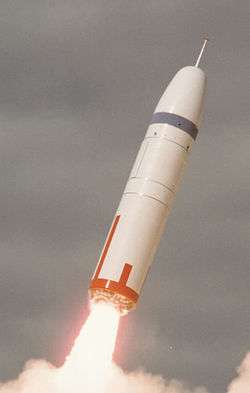UGM-96 Trident I
| UGM-96 Trident I (C4) | |
|---|---|
|
The first launch of a Trident I with a drag-reducing aerospike, from Cape Canaveral, on 18 January 1977 | |
| Type | SLBM |
| Place of origin | United States |
| Service history | |
| Used by | United States Navy |
| Production history | |
| Manufacturer | Lockheed Missiles Division |
| Specifications | |
| Weight | 73,066 pounds (33,142 kg) |
| Length | 33 feet (10.2 m) |
| Diameter | 71 inches (1.8 m) |
| Warhead | thermonuclear weapon multiple independently targetable reentry vehicles (MIRV). Eight W76 (100 kt) warheads (Mark 4). |
|
| |
| Engine | Solid-fuel rocket |
Operational range | 4,600 miles (7,400 km) |
Guidance system | Astro-inertial guidance |
| Accuracy | CEP: 1250 ft (380 m)[1] |
Launch platform | Ballistic Missile Submarine |
The UGM-96 Trident I, or Trident C4, was an American submarine-launched ballistic missile, built by Lockheed Martin Space Systems in Sunnyvale, California. First deployed in 1979, the Trident I replaced the Poseidon missile. It was retired in 2005,[2] having been replaced by the Trident II. In 1980, the Royal Navy requested Trident I missiles under the Polaris Sales Agreement; in 1982, this was changed to Trident IIs. It was the first Trident missile to enter service.
The Trident I is a three-stage, solid-fuelled missile.
The first eight Ohio-class submarines were armed with Trident I missiles. Twelve James Madison- and Benjamin Franklin-class submarines were also retrofitted with Trident I missiles, which replaced older Poseidon missiles.
See also
References
- ↑ Parsch, Andreas. "UGM-133". Directory of U.S. Military Rockets and Missiles. Retrieved 2009-02-14.
- ↑ Popejoy, Mary (November 5, 2005). "USS Alabama Offloads Last of C4 Trident Missiles". navy.mil. US Navy. Retrieved May 16, 2012.
| Wikimedia Commons has media related to UGM-93A Trident I C-4. |
This article is issued from
Wikipedia.
The text is licensed under Creative Commons - Attribution - Sharealike.
Additional terms may apply for the media files.
